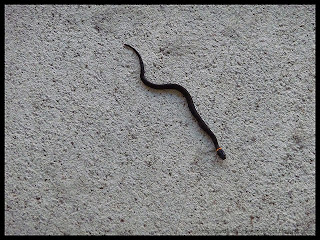If you have been following this blog you will know we bought a vacation home last year giving me the opportunity to garden in two very different hardiness zones. It has meant learning about various critters that visit our southern garden. There are venomous snakes and spiders there so it is important to identify these types of visitors to avoid possible bites.
Ringneck snakes are common harmless, beneficial snakes in Florida. They feed on earthworms, slugs, small skinks, lizards and tiny frogs. As with any snake they may bite if cornered but it is non-toxic to people. Ringneck snakes are sociable so they are usually found with other ringneck snakes. They reach a length of about 2 feet at maturity. Newly hatched ringneck snakes are prey for large spiders and centipedes.
Ringneck snakes have a rather unusual defensive trait. When disturbed the turn upside down displaying their orangy red underside upwards in a curled fashion. It could be the orangy red colouration serves as a visual warning to predators that they may be distasteful or poisonous. It could be just a camoflauge method for prey to trick them into thinking the snake is already dead very similar to how an opossum plays dead to avoid predation. The ringneck snake also releases a foul-smelling odour to defend against predators. If playing dead and the odour doesn't work the snake will viciously bite.
Happy Gardening!
Garden Gnome
©2006-2011






















I don't like snakes, but as long as they stay outside and I don't see them, I'm fine with them.
ReplyDeleteOur retirement home will have copperheads (poisonous), cottonmouths (poisonous), and corn snakes (non poisonous) among others. And since there are an over abundance of mice and rats (farming area) I'm okay with snakes outdoors. I just need to remember to be careful when around wood piles and such.
That's the first ringneck snake I've ever seen. Didn't know about them so thank you for that. :-)